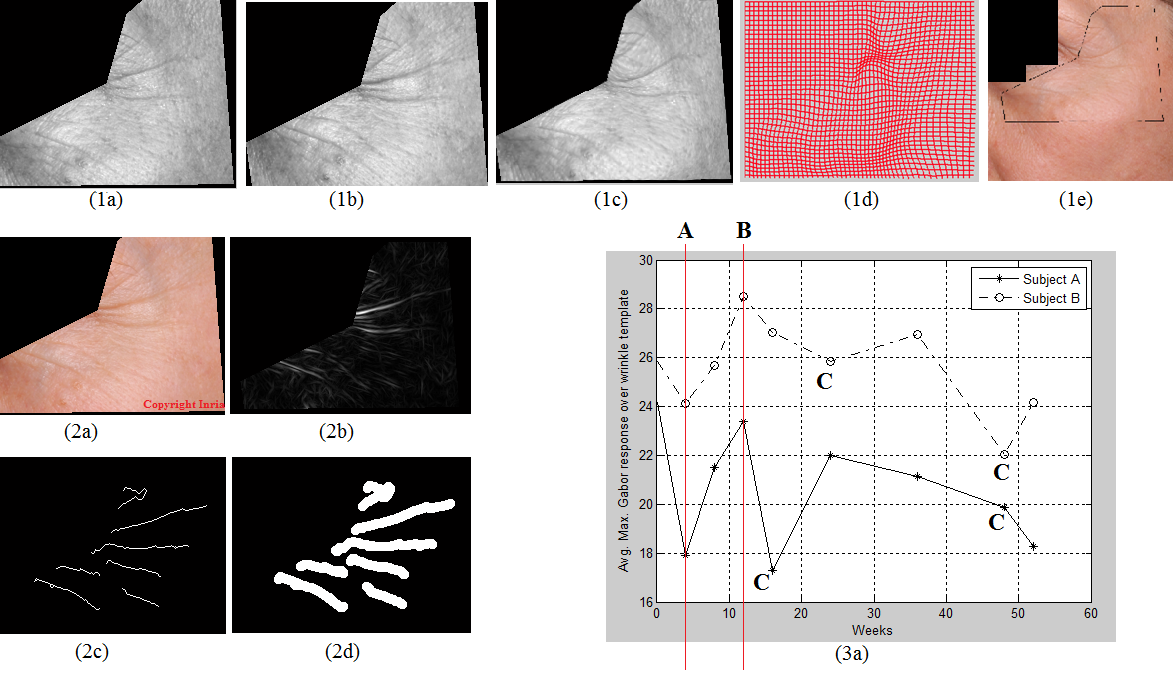Section: New Results
Other detection approaches
Image-based evaluation of treatment responses of facial wrinkles using LDDMM registration and Gabor features
Participants : Nazre Batool, Josiane Zerubia [contact] .
Face, skin texture, detection of wrinkles, LDDMM registration, response to treatment, Gabor filters, morphological processing
The goal of this work is to evaluate quantitatively the subtle variations in facial wrinkles for the same subject in response to treatment using image-based analysis. The novelty of this application is that a series of images of the same subject over a shorter time period of weeks are analyzed instead of more prevalent inter-person analysis of facial images. To overcome the challenges of detecting and evaluating such subtle changes, we propose a framework to compare image features in key wrinkle sites only while excluding the noise introduced by changes in surrounding skin texture. After initial registration using facial landmarks such as corners of eyes, nose, mouth, we propose a method based on Large Deformation Diffeomorphic Metric Mapping (LDDMM) to achieve finer registration. Fig. 10 (1a-1e) shows an example of registration using LDDMM for a pair of images. Then we use N. Batool's previously proposed algorithm (Nazre & Chellappa (2015)) to detect key wrinkle sites. The algorithm is based on ‘scaled’ maximum Gabor filter responses and the incorporation of geometric constraints via morphological image processing. The binary output from the algorithm is used to create a unique wrinkle template for each subject. Fig. 10 (2a-2d) an example of obtaining a unique wrinkle template from an image using Gabor responses and wrinkle detection algorithm in (Nazre & Chellappa (2015)). Gabor responses in this template,in time series images are compared to detect subtle changes for a subject. We do not adopt the direct approach of comparing filter responses in the whole image instead of those in wrinkle template only because such an approach causes intermingling of skin texture variations in non-wrinkle sites with changes in wrinkle sites degrading the overall accuracy.
|
Fig. 10 (3a) shows a plot of results for two subjects where y-axis shows average maximum Gabor amplitude response in key wrinkle sites and x-axis corresponds to the number of weeks after the treatment. For both subjects a significant drop in the average response can been seen 4 weeks after the treatment (event ‘A’). An increase in the Gabor response happened at week 12 (event ‘B’) which coincided with slight darkening/reddening of skin for both subjects. On the other hand, event ‘C’ represents co-occurrence of skin lightening with a decrease in Gabor response. These preliminary results indicate trends in wrinkle responses to treatment, skin darkening and lightening. In future, these trends will be validated by more rigorous experiments.
SAR data classification using generalized Gamma mixture model
Participant : Josiane Zerubia [contact] .
This work has been performed in collaboration with Dr. Vladimir Krylov (University of Genoa, Italy), Prof. Heng-Chao Li, Prof. Ping-Zhi Fan (Southwest Jiaotong University, Chengdu, China) and Prof. William Emery (University of Colorado, Boulder, USA).
SAR images, statistical modeling, generalized Gamma mixture model
The accurate statistical modeling of synthetic aperture radar (SAR) images is a crucial problem in the context of effective SAR image processing, interpretation and application. In this work a semi-parametric approach is designed within the framework of finite mixture models based on the generalized Gamma distribution (GD) in view of its flexibility and compact analytical form. Specifically, we have developed a generalized Gamma mixture model (GMM) to implement an effective statistical analysis of high-resolution SAR images and proved the identifiability of such mixtures. A low-complexity unsupervised estimation method has been derived by combining the proposed histogram-based expectation-conditional maximization algorithm and the Figueiredo-Jain mixture estimation algorithm. This resulted in a numerical maximum likelihood (ML) estimator that can simultaneously determine the ML estimates of component parameters and the optimal number of mixture components. The state-of-the-art performance of the proposed method has been validated experimentally on a wide range of high-resolution SAR amplitude and intensity images.
|
In Fig. 11 we demonstrate a typical result of the developed statistical modeling technique on a portion of a multilook airborne RAMSES (©CNES, ONERA) sensor acquisition over Toulouse suburbs (single polarization, downsampled to approximately 2m ground resolution). The unsupervised GMM estimate contains five components and reports a very accurate result that outperforms the considered benchmark statistical modeling methods. In order to visualize the estimated five statistical components we also report a maximum likelihood classification map.




